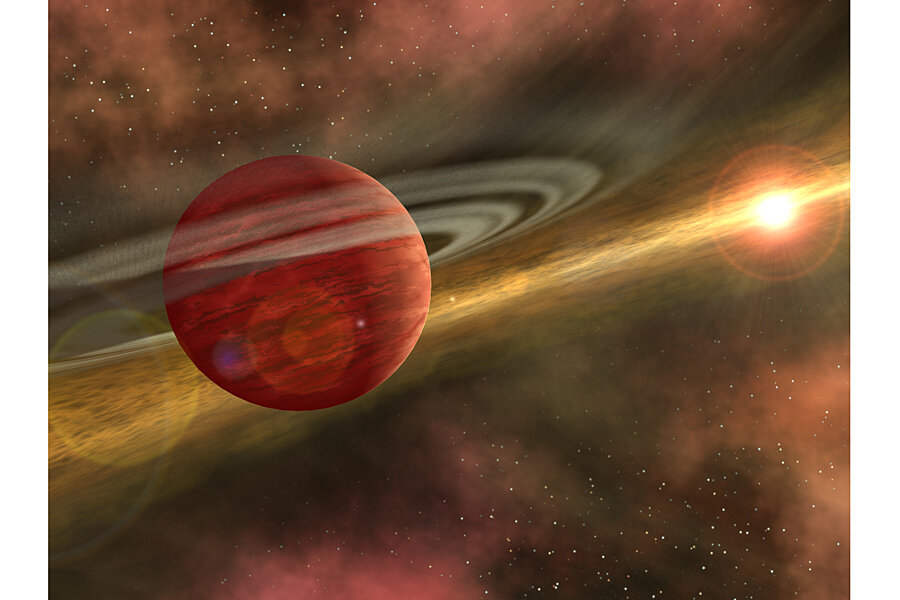What's that Jupiter-like thing doing so far afield from nearest star?
Astronomers have discovered a super Jupiter in a record-smashing orbit for a sun-like star, far outside the disk of dust and debris that rings the star and that typically gives rise to planets.
The team reporting the discovery has ruled out the typical explanation that could account for the planet's remarkable orbit – which is some 650 astronomical units (AU), or 650 times the distance between Earth and the sun.
Giant planets generally are found in orbits a few tens of AU from their stars, other researchers have noted, and form from the primordial disk of dust around their stars.
Instead, the researchers posit that this new-found gas giant, with 11 times Jupiter's mass, may have formed where it is from a much smaller clump of gas than the clump that gave rise to the star, HD 106906. As a result, its effort to become a star would have been hauled up short well before it could grow massive enough to ignite fusion reactions at its core and shine.
Whereas the smaller star in a typical binary system has about 10 percent of the mass of the larger star, the planet, dubbed HD 106906b, has less than 1 percent of its host star's mass.
In the end, however, such explanations are educated guesses, acknowledges Vanessa Bailey, an astronomer at the University of Arizona who led the international team that found the planet. How such objects form “is really an open question,” she says.
It's one that is becoming more salient among scientists studying planet formation. During the past few years, researchers have uncovered a range of giant planets orbiting at distances from about 100 AU to more than 1,000 AU – distances that current theories of planet formation or the formation of binary stars can't easily accommodate.
Even as Ms. Bailey's team unveiled its discovery this week, another team led by University of Texas astronomer Adam Kraus has reported finding three more planets orbiting their host stars at distances from 140 to 330 AU. Formal reports of both teams' finds have been accepted for publication, one in the Astrophysical Journal Letters and the other in the Astrophysical Journal.
HD 106906b and its star are 300 light-years away, amid a large assembly of stars visible in the Southern Hemisphere and known as the Lower Centarus Crux. The assemblage includes the constellation Southern Cross.
Bailey says she undertook the observation initially to hunt for stars whose circumstellar debris disks have gaps in them or show other evidence that the system might host planets.
Bailey's team directly imaged the planet-like object, which it cautiously calls a “planetary-mass companion,” using an infrared camera bolted to the back of the 6.5-meter Magellan Telescope at the Las Camapanas Observatory high in Chile's Atacama Desert. The telescope has a new system of adaptive optics, which compensates for the distorting effect that Earth's atmosphere has on incoming starlight.
On the trip home to Arizona, she began to process the data and spotted the pinpoint of light that turned out to be HD 106906b. Before the team claimed a detection, it used additional data from the Hubble Space Telescope archives, from a previous study, and from followup observations of the object's spectrum to determine that it wasn't a star and that it was a companion to HD 106906.
It's hard to say how it got there, the researchers acknowledge. The object's mass falls just below a threshold astronomers have established to sift large planets from brown dwarfs. Brown dwarfs are runt stars that never gained enough mass to sustain the fusion reactions at their cores. The boundary, which itself is subject to debate, is 13 times the mass of Jupiter.
Typically, planets are thought to form as material in the disk clumps, then begin to build enough gravity to continue accreting surrounding material. The star HD 106906 is only 13 million years old. Where HD 106906b resides, at 530 AU from the estimated outer edge of the debris disk encircling the nearest star, there isn't enough material to build an 11 Jupiter-mass planet within that time span, if at all, explains Eric Mamajek, an astronomer at the University of Rochester in Rochester, N.Y., and a member of the team reporting the results.
Nor does the planet-mass object appear to have formed closer in, only to be kicked out through gravitational interactions with other planets. The system shows no evidence of other planets yet, let alone any with sufficient heft to give HD 106906b the boot.
“The idea now is that there are probably things that form like planets and form like stars around that 13-Jupiter-mass boundary,” Dr. Mamajek says.
“But things could be even more exotic than we think,” he adds.
For instance, stars form after the gravitational collapse of clouds of dust and gas. This could play out on a smaller scale in the disks that form around stars.
“There could be two or three different ways of forming objects in this mass range,” and it's tough to figure out which one is at play, he says. “All we see is an atmosphere.”
One test would involved gathering information on the chemical composition of the object's atmosphere – a difficult measurement to make with current technology, Bailey says. If the make-up of the object's atmosphere were comparable to that of the star, that would suggest that HD 106906b is a brown-dwarf wannabe with a serious case of arrested development.
Alternatively, if astronomers could determine the density of the object by measuring its size and getting a more precise measure of its mass, they could calculate its density. This would yield clues to its bulk composition – including that of any core around which material could accrete. This would help sort among various possible formation mechanisms.
For now, ask Mamajek how HD 106906b got there, and his answer is direct: “We don't know.”






